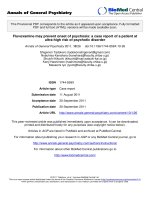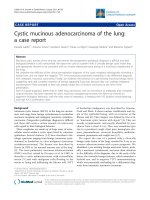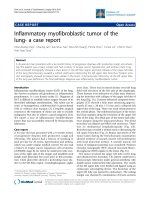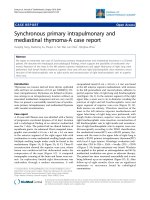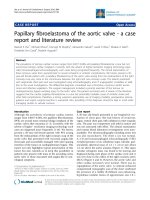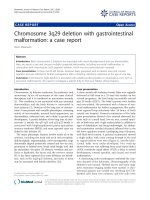Báo cáo y học: " Deep venous thrombosis after office vasectomy: a case report" ppt
Bạn đang xem bản rút gọn của tài liệu. Xem và tải ngay bản đầy đủ của tài liệu tại đây (388.62 KB, 4 trang )
CAS E REP O R T Open Access
Deep venous thrombosis after office vasectomy:
a case report
David A Cooke
1*
, Philip Zazove
2
Abstract
Introduction: Postoperative pulmonary embolism is considered a complication of major surgery. However,
thromboembolism can also occur following minor procedures. We report a case of a major embolic event
following a straightforward office vasectomy.
Case presentation: A healthy 35-year-old Asian man underwent an uncomplicated office vasectomy. Soon after,
he noticed vague chest pain and dyspnea. Lower extremity Doppler ultrasound revealed acute venous thrombosis.
A computer-assisted tomography angiogram revealed extensive bilateral pulmonary emboli. Extensi ve laboratory
work-up failed to identify thrombophilia. He has not had any recurrences in the eight years since the initial
presentation.
Conclusion: This case highlights that major embolic events can follow minor office procedures. Patients with
suggestive findings should be investigated aggressively.
Introduction
Pulmonary embolism is a well-known complication of
major surgery but it is not always appreciated that it
can occur even after minor interventions. Thromboem-
bolism has been reported af ter outpatient surgeries of
many types. However, there a re very few reports of
thromboembolism associated with an office vasectomy.
We believe that, although the incidence of this compli-
cation is low, it does occur and physicians should be
aware of this if a patient presents with symptoms sug-
gestive of an embolic event.
Case presentation
A 35-year-old Asian man without a significant medical
history presented to our health center for elective outpa-
tient vasectomy. The procedure was performed bilater-
ally using the no-scalpel approach in an office setting
over 30 minutes without any apparent incident or com-
plication and he was discharged . He returned home and
reporte d that he slept for about two hours in bed. Upon
arising, he noticed that he felt somewhat short of breath
and experienced dyspne a on exe rtion as well as vague
substernal chest pain; none of his symptoms were
sufficiently severe to lead him to s eek immediate medi-
cal attention.
He subsequently presented to his primary care physi-
cian (PCP) four days fol lowing the vasectomy procedure
because of continued feelings of shortness of breath and
chest pain. The rest of the history was unremarkable, as
was his physica l examination and el ectrocardi ogram. He
had no swelling, tenderness, warmth or redness of his
legs. There was some mild tenderness and ecchymoses
at the operative site but no edema or swelling.
In light of his recent procedure and his symptoms,
lower extremity Doppler ultrasound studies were
ordered and performed 36 hours after his visit to the
PCP. The Doppler studies demonstrated venous throm-
bosis in the right popliteal vein. A computed tomogram
(CT) angiogram was immediately arranged which re-
demonstrated a clot in the right pop liteal vein ( Figure
1).Additionally,italsodemonstratedlarge,multiple,
bilateral pulmonary emboli (Figures 2 and 3).
He did not have any prior history of deep venous
thrombosis (DVT) and was not aware of any family his-
tory of the disorder. He was taking no medications at
the time of t he vasectomy. He was a non-smoker. An
extensive laboratory work-up was performed in search
of any underlying disorders predisposing to thromboem-
bolism (Table 1). All studies returned within the normal
* Correspondence:
1
Department of Internal Medicine, University of Michigan Medical Center,
Ann Arbor, Michigan, USA
Cooke and Zazove Journal of Medical Case Reports 2010, 4:242
/>JOURNAL OF MEDICAL
CASE REPORTS
© 2010 Cooke and Zazove; licensee BioMed Central Ltd. This is an Open Access article distributed under the terms of the Creative
Commons Attribution License ( which permits unrestricted use, distribution, and
reprodu ction in any medium, provided the original work is properly cited.
limits. D-Dimer and Factor VIII levels were not checked,
as these tests were not routinely utilized as part of a
thromboembolic workup at the time of the event.
The patient was treated initially for his pulmonary
embolism as an outpatient with enoxaparin and then
switched to warfarin for six months. The patient toler-
ated this therapy well and did not develop any bleed-
ing complications or symptoms suggestive of recurrent
embolism. A CT angiography of the chest, pelvis and
legs was repeated 76 days after the initial study to
confirm resolution of the thrombi. This demo nstrated
complete resolution of the pulmonary emboli, with no
residual clot in the pulmonary or lower extremity
venous systems. Symptomatically, he has also returned
tobaselinebythispoint.Todate,hehasnot
had any evidence of recurrent thrombosis or
thromboembolism.
Discussion
We present here the case of a previously healthy man
who developed extensive pulmonary em boli shortly after
an elective vasectomy procedure. We believe there is a
direct relationship between the two events, most likely
mediated by venous stasis and inflammation fro m pro-
cedural trauma.
It is impossible to exclude a chance association in our
case between the thromboembolic event and the vasect-
omy. However, our patient had no identifiable underly-
ing hypercoaguabl e state and he has not had any
recurrent thromboembolism in the eight years since his
vasectomy. These factors strongly suggest that his
thromboembolism resulted from the procedure.
While the association we propose is not generally
known, there is limited precedent in the medical litera-
ture. Two articles by Roberts [1,2] in 1968 and 1971
hypoth esi zed there is an association between vasectomy
and t hrombophlebitis. However, these cases reported a
delay of several years between the vasectomies and the
presumed related thrombotic events. Another case
report in 1973 posits a relationship but, again, several
months elapsed between vasectomy and the thrombotic
event [3]. Recently, Teachey [4] reported a case of pul-
monary embolism occurring soon after vasectomy and
we believe the similarity of this case adds support to our
argument.
The operating physician in this case has performed
hundreds of vasectomies over a period of more than 20
years and this is the first such a complication that he
has seen. Together with the very sma ll number of simi-
lar reports, this suggests that post-vasectomy throm-
boembolism represents an extr emely rare complication
of the procedure.
It is interesting that this occurred despite using the
no-scalpel vasectomy technique, which is known to be
quicker and less traumatic than the traditional approach.
We wondered whether the fact that a resident was
Figure 1
Figure 2 Figure 3
Cooke and Zazove Journal of Medical Case Reports 2010, 4:242
/>Page 2 of 4
involved in doi ng the vasectomy on our patient was a
factor in the development of postoperative complica-
tions. The attending sur geon usually completes most
vasectomies in 15-20 min; in this case, the procedure
probably lasted around 30 or even 35 min. The litera-
ture suggests that a resident performing a procedure,
under the close supervision of a faculty (which was the
case in this patient), does not increase the risk of com-
plications. This has been studied using a variety of pro-
cedures, including cardiac, otolaryngologic and general
surgery situations [5-10].
Conclusion
This case highlights the need to be aware that major
embo lic events can occur after even m inor office proce-
dures. Patients at risk for developing clots should be
mana ged appropriately before and du ring the surgery in
order to reduce the c hances of a problem. In addition,
patients presenting with suggestive symptoms and signs
of a DVT or pulmonary embolus after a procedure
should be investigated aggressively.
Consent
Written informed consent was obtained from the patient
for publication of this case report and accompanying
images. A copy of the written consent is available for
review by the Editor-in-Chief of this journal.
Abbreviations
CT: computed tomogram; DVT: deep venous thrombosis; PCP: primary care
physician.
Author details
1
Department of Internal Medicine, University of Michigan Medical Center,
Ann Arbor, Michigan, USA.
2
Department of Family Medicine, University of
Michigan Medical Center, Ann Arbor, Michigan, USA.
Authors’ contributions
PZ and DC both directly participated in the care of this patient, both
contributed substantially to the text of the article and the literature review.
Both authors read and approved the final manuscript.
Competing interests
The authors declare that they have no competing interests.
Received: 21 October 2009 Accepted: 4 August 2010
Published: 4 August 2010
References
1. Roberts HJ: Delayed thrombophlebitis and systemic complications after
vasectomy: possible role of diabetogenic hyperinsulinism. J Am Geriatrics
Soc 1968, 16(3):267-280.
2. Roberts HJ: Thrombophlebitis after vasectomy (Letter). NEJM 1971,
284:1330.
3. Alt WJ: Thrombophlebitis and pulmonary emboli following vasectomy.
Michigan Med 1973, 72(33):769-770.
4. Teachey DT: Saddle pulmonary embolism as a complication of
vasectomy. Urology 2008, 71(351):e5-e6.
5. Kisker CT, Wu KK, Culp DA, Hackett JG, Hess EV, Houk JL: Blood coagulation
following vasectomy. JAMA 1979, 241(15):1595-8.
6. Sussman EJ, Kastanis JN, Feigin W, Rosen HM: Surgical outcome for
resident and attending surgeons. Am J Surg 1982, 144(2):250-253.
Table 1 Selected test values for patient
Test Patient result Lab normal
White blood count 5.8 K/mm
3
4.0 - 10.0 K/mm
3
Red blood count 5.13 K/mm
3
4.50 - 5.90 K/mm
3
Hemoglobin 15.3 g/dL 13.0 - 17.3 g/dL
Platelet count 206 K/mm
3
150 - 450 K/mm
3
Westergren sedimentation rate 8 mm/h 0 - 15 mm/h
Prothrombin time 13.2 s 10.5 - 13.5 s
International Normalized Ratio 1.0
Partial thromboplastin time 31.3 s 25.0 - 32.6 s
Dilute Russell viper venom time 25.8 s 24.8 - 38.0 s
TT inhibition 0.9 (1:100)
0.8 (1:1000)
0.0 - 1.2
0.0 - 1.2
Homocysteine 12 μmol/L 5 - 15 μmol/L
Protein C activity 115% 81% - 160%
Protein C antigen 92% 60% - 106%
Protein S antigen, free 50% 43% - 132%
Antinuclear antibody 1:80 (speckled pattern) Negative
lgG Phospholipid antibody 11 GPL 0 - 22 GPL
lgM phospholipid antibody 5 MPL 0 - 10 MPL
Antithrombin III activity 101% 82% - 119%
Antithrombin III antigen 32.0 mg/dL 20.0 - 32.0 mg/dL
Factor V Leiden mutation Negative Negative
Cooke and Zazove Journal of Medical Case Reports 2010, 4:242
/>Page 3 of 4
7. Sethi GK, Hammermeister KE, Oprian C, Henderson W: Impact of resident
training on postoperative morbidity in patients undergoing single valve
replacement. Department of Veterans Affairs Cooperative Study on
Valvular Heart Disease. J ThoracicCardiovascular Surg 1991,
101(6):1053-1059.
8. Shaked A, Calderom I, Durst A: Safety of surgical procedures performed
by residents. Arch Surg 1991, 126(5):559-560.
9. Elder S, Kunin J, Chouri H, Sabo E, Matter I, Nash E, Schein M: Safety of
laparoscopic cholecystectomy on a teaching service. Surgl Laparoscopy
Endoscopy Percutaneous Techn 1996, 6(3):218-220.
10. Manolidis S, Takashima M, Kirby M, Scarlett M: Thyroid surgery: a
comparison of outcomes between experts and surgeons in training.
Otolaryngology Head Neck Surg 2001, 125(1):30-33.
doi:10.1186/1752-1947-4-242
Cite this article as: Cooke and Zazove: Deep venous thrombosis after
office vasectomy: a case report. Journal of Medical Case Reports 2010
4:242.
Submit your next manuscript to BioMed Central
and take full advantage of:
• Convenient online submission
• Thorough peer review
• No space constraints or color figure charges
• Immediate publication on acceptance
• Inclusion in PubMed, CAS, Scopus and Google Scholar
• Research which is freely available for redistribution
Submit your manuscript at
www.biomedcentral.com/submit
Cooke and Zazove Journal of Medical Case Reports 2010, 4:242
/>Page 4 of 4
